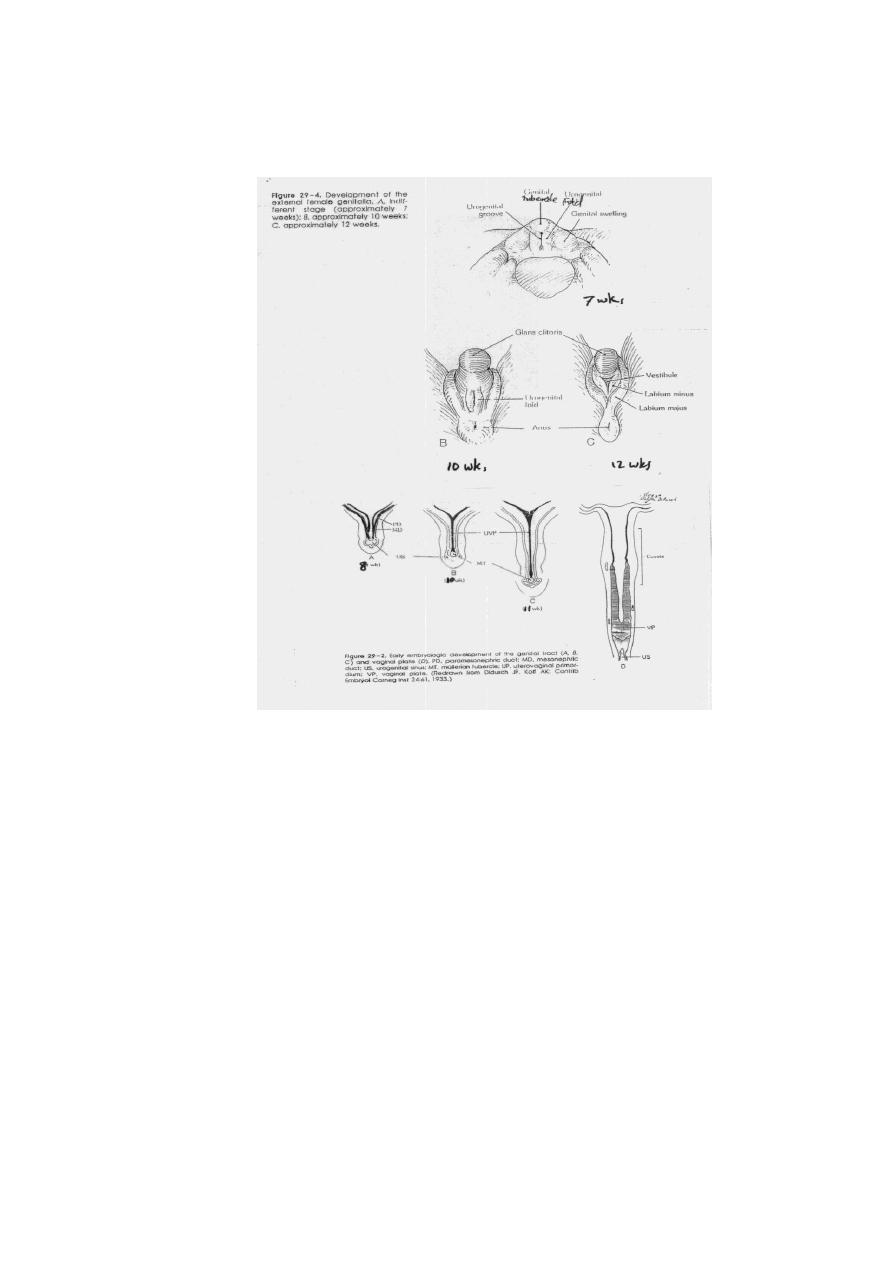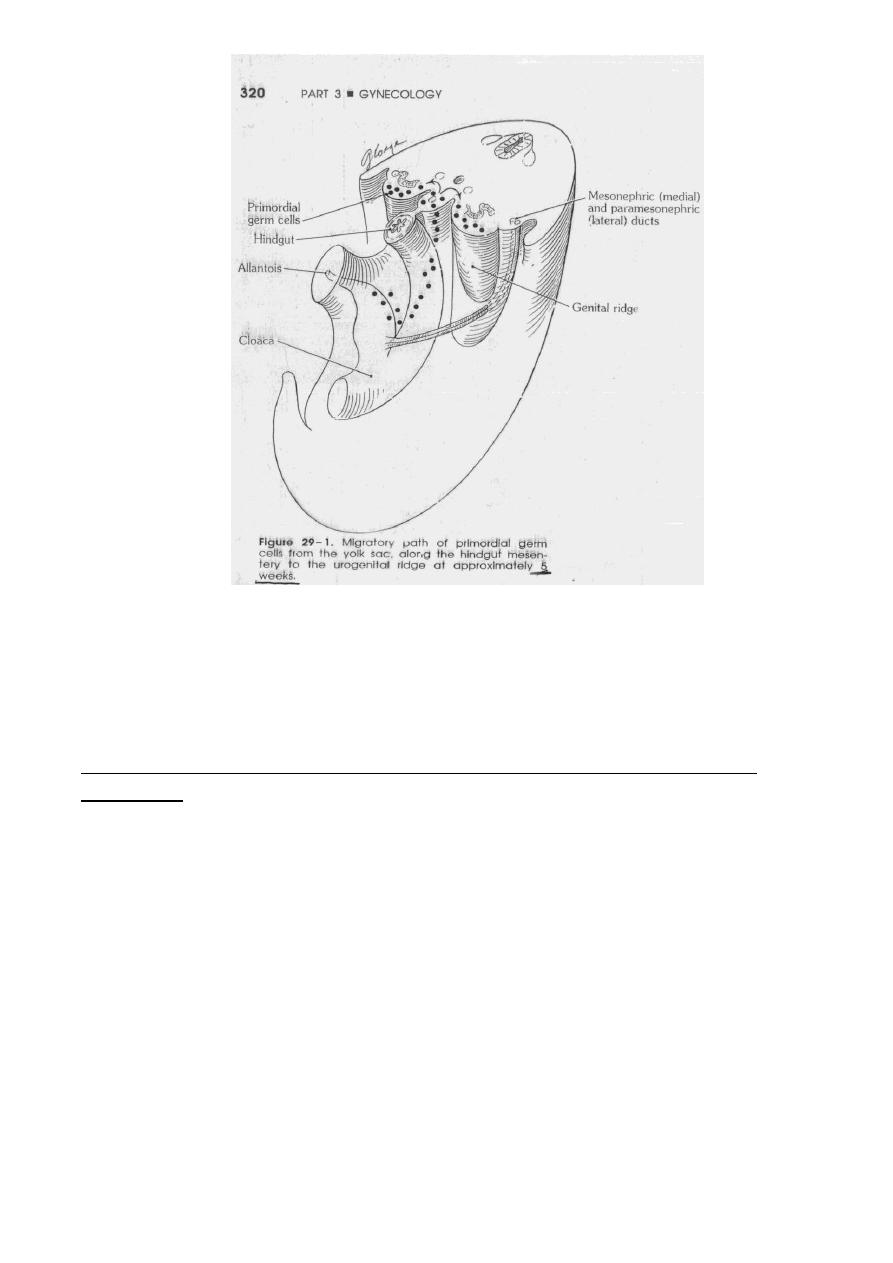
1
Fifth stage
Gynaecology
Lec-1
د.اسماء
27/10/2015
Normal development of the female genital tract
Introduction:
Following fertilization the normal embryo contains 23 sets of chromosomes ,including 22
autosomes and one sex chromosomes from each parent.
46XY embryo will develop as a male
46XX embryo will develop as a female
It’s the presence or the absence of the Y chromosome which determines whether the
undifferentiated gonad becomes a testis or an ovary.
The testis determining factor is on the Y chromosome on a gene termed the SRY (sex
determining region of the Y chromosome). This gene triggers testis formation from the
indifferent gonad.
The development of the differentiated gonad is fundamental for the development of the
other genital organs .testes leads to male genital organs , absence of testis leads to female
genital Organ.
Development of the female genital tract
The genital organs and those of the urinary tract arise in the intermediate mesoderm on
either side of the root of the mesentery beneath the epithelium of the coelom .
The mesonephric(wolffian) duct appear in association of the pronephros (transient tubules
in the cervical) and extends caudally to open at the cloaca .
The mesonephros , the second primitive kidney develops as a swelling bulging into the
dorsal wall of the coelom of the thoracic and upper lumber region.
The mesonephros in the male persists in part as the excretory portion of the male genital
system ; in the female only a small vestiges survive
The genital ridge in which the gonads of each sex develop is visible as a swelling on the
medial aspect of the mesonephros .
The paramesonephric duct which forms much of the female genital tract develops as in
growth of the coelomic epithelium laterally , then become a groove then as a tube below
the surface

2
The uterus and the fallopian tubes
The two paramesonephric ducts extend caudally until they reach the urogenital sinus
(about nine weeks gestation).
The blind end will project into the posterior wall of the sinus to form the Mullerian
tubrcule. At the beginning of the third month both the Mullerian and the wolffian ducts are
present and capable of development .
In the male there is development of the wolffian duct and degeneration of the
paramesonephric duct as a result of the production of the Mullerian inhibitory factor (MIF)
produced by the fetal testis.
In the female there is degeneration of the wolffian system and marked growth of the
mullerian system .(absent MIF)
The lower ends of the Mullerian ducts come together in the midline ,fuse and develop into
the uterus and cervix. The cephalic ends of the duct remain separate to form the fallopian
tubes.
Proliferation of the mesenchyme a round the fused portion of the ducts form the thick
muscular wall of the uterus and the cervix.
The vagina:
At the point of fusion of the para -mesonephric duct to the dorsal wall of the urogenital
sinus ( the Mullerian tubercule) there is marked growth of the tissues from which the
vagina will forms, known as the vaginal plate, extending between the cervix and the
urogenital sinus. canalization of the vagina occurs and completed around the 20-24
weeks gestation. Incomplete canalization at any level result into a vaginal septum and
outflow tract obstruction.
The external genitalia :
The primitive cloaca becomes divided by a transverse septum
into an anterior urogenital portion and posterior rectal portion .
The urogenital portion of the cloacal membrane breaks down and it’s divided into three
portions ; external expanded phallic part, a deeper narrow pelvic part (between it and the
region of the Mullerian Tubercle ), and a vesico -urethral part connected superiorly into
the allantois .
Externally in this region the genital tubercle forms a conical projection around the
anterior part of the cloacal membrane .
Two pairs of swelling on the medial part (genital folds),
Two lateral pairs (genital swelling) formed by proliferation of mesoderm around the end
of the urogenital sinus . Development till ten weeks is the same in the male and female
and differentiation occur later.

3
The vesicourethral portion of the urogenital sinus forms the bladder and urethra , the pelvic
and the phallic portion forms the vestibule , the genital tubercle enlarge slightly and forms
the clitoris ,the genital fold form the labia minora , the genital swelling enlarges to form the
labia majora.
The Gonads :
The primitive gonads will appear in the embryo at 5 wks. as a proliferation of the
coelomic epithelium on the medial aspect of the urogenital ridge and grows into
mesenchyme (primary sex cord) and the gonads now have outer cortex and inner
medulla.
In embryos with XX complement , the cortex differentiate to form most of the ovary and
the medulla regresses .
The primordial germ cells develop by the four week in the endodermal cells of the yolk
sac and during the five week they migrate along the dorsal mesentery of the hind gut to
the gonadal ridge and become incorporated into the mesenchyme and the primary sex
cord by six week.

4
In the ovary there is active growth of the sex cord forming the pregranulosa cells which
surround the oocyte. There is active growth phase make the largest number of oocyte
surrounded by pregranlosa cells there is about seven million at twenty weeks , at birth
it’s about (two million).
Those oocyte who fails to surround themselves with the pregranulosa cells will
disintegrate
Follicular development will become evident by twenty eight wks. of intrauterine life .
In XY embryo the testicular differentiation is evident by seven week by disappearance of
the germ cells from the cortex and the cells differentiate into fibroblasts which form the
tunica albuginea . The deeper parts of the sex cord give rise to the rete testis and the
seminiferous and straight tubules.
